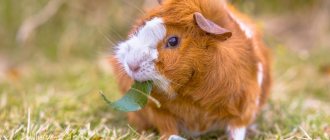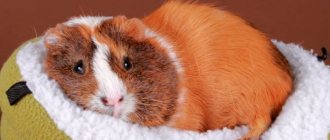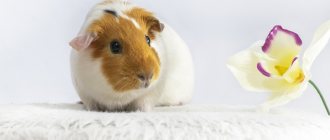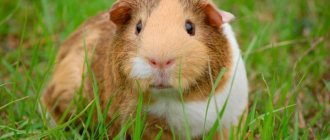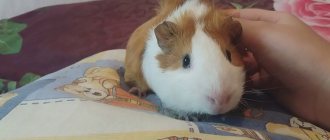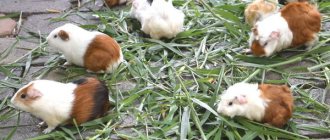- home
- Guinea pig
- Guinea pig behavior
02/07/2019 Guinea pigs are cute and generally unpretentious pets. But sometimes they begin to chew on the bars of the cage, causing fears for their health. There are several possible reasons for this behavior that you need to be aware of in advance.
Possible reasons
If your guinea pig chews on the cage occasionally, there is no need to worry. Accidentally noticed teeth marks only indicate that the pet was bored at that moment. However, if literally every day fresh damage is discovered on the rods, this is a reason to think about it.
- Guinea pigs are very active animals; a small cage is a real punishment for them. A cramped cage standardized to “30 cm by 40 cm” will not work; they will try to get out of it.
- These cute pets are social; without their relatives they can become sad. Therefore, if a pig lives alone in a cage, out of boredom, it is quite capable of starting to chew on the cage. Owners need to think about when was the last time they delighted their little animal with a new toy?
- When under stress, a guinea pig chews on the bars of its cage, this is a known fact. Unfamiliar people or surroundings can cause anxiety.
- You can’t abandon your pet, he needs attention. Moreover, it must be constant, otherwise the opposite situation will arise. The pig will decide that as soon as it starts gnawing on the bars, the owner will take it in his arms or treat it with a treat.
It is irresponsible to assume that an animal spoils the appearance of the cage due to the need to grind down its teeth. These are not rats that need to constantly chew something due to the growth of the front incisors. As a rule, they have enough roughage for this. For variety, you can carefully place twigs and pieces of wood in the cage. This is undeniably better than gnawing on paint-covered bars of a cage.
How to wean it off?
If your pet has started gnawing on its cage at night, then you should be prepared for the fact that it is almost impossible to wean it from this action.
Nevertheless, it’s worth a try, because experts offer various methods. It is worth focusing on replacing the object that the hamster is gnawing on. You should definitely add grass and vegetables to your animal’s food, as well as hard foods, with their help he can grind them down. Constant growth of teeth can not only harm the animal, for example, injure the mouth, but also lead to its death. If the situation is already very advanced, you should seek help from a specialist who will shorten them
But this method is already emergency; it is worth switching to it if other options have not brought results.
Pay attention to the rodent's food. It should include all essential vitamins and minerals
It is worth adding mineral stone to it, as well as tree branches. For a small investment, your hamster will get a lot of benefits and will forget about chewing on the cage.
If an animal feels a large amount of energy, but it is not directed in the right direction, then it may become interested in its cage. The solution to this problem will be to increase the load. It is enough to present the rodent with new apartments, more spacious. You can complement the cage with various accessories. An excellent choice would be a running wheel or ball.
Important! Experts advise combining several methods so that the animal’s interest in the cage disappears. For example, you can treat your hamster with his favorite treat and put on a running wheel.
This will save you from noise, the hamster will be able to keep himself in shape, thereby strengthening his immune system.
For example, you can treat your hamster to his favorite treat and put on a running wheel. This will save you from noise, the hamster will be able to keep itself in shape, thereby strengthening its immunity.
It is worth taking a closer look at the most common methods.
Favorite treat. Today there is a wide selection of treats for rodents on sale. You can treat your pet not only with chips, but also with dried fruits. It is better to give preference to something hard so that the animal can grind down its teeth. You should give the treat once a day before bedtime. This way, you can enjoy your sleep, and the animal will be busy with its own business.
Mineral stone is a very useful device because it includes both vitamins and beneficial elements. In appearance, it is no different from an ordinary stone. Such a stone can be purchased at a pet store, and it will last for a long period. To make it more convenient for the hamster to chew on it, the stone should be fixed on the wall of the cage or on a branch.
Twigs of various trees
You can prepare them yourself, but you should pay attention that they should not contain harmful resins, since they are toxic to animals. You should prepare small twigs and carefully cut off all protruding and prickly parts to protect the hamster from possible injury.
The branches should be secured in the cage. It is necessary to monitor them in order to replace them with new ones in time, then your pet will always have an interesting activity.
Some experts advise using some unpleasant substance to discourage the animal from gnawing on the bars of the cage. But it is strictly forbidden to use chemical solutions that can lead to the death of the animal. The best choice would be lemon juice or red pepper. If the baby understands that the cage is not tasty, then soon the desire will disappear by itself.
You can cope with the situation with the help of a special spray, but it does not work on all hamsters. Sensitive people usually feel its effects. Its effectiveness is individual.
It is worth paying attention to when and in what place he chews the rods. For example, if he takes action when he sees you with food, then he is simply hungry. If he chews on a place near the door, then the animal wants to take a walk. Once you fulfill his wish, he will stop bothering you.
What to do to wean
The best way to stop your guinea pig from chewing its cage is to eliminate one of the problems described above that is occurring. Get a same-sex pet for your pet, don’t deprive it of attention, or buy special chewing sticks. If the problem has been resolved, you should continue to stick to your actions.
But if the pig is still restlessly gnawing on the cage, the reason is its small area. It is best to buy another cage or make it yourself. The latter case is even preferable, since you can choose sizes that are convenient for the room.
But what to do if it is not possible to immediately eliminate the problem, but you need to wean your pet from a bad habit? Experienced breeders advise lubricating the rods with vinegar; guinea pigs do not like it. But this method cannot always be used; the animals will feel not only cramped, but also stressed.
Consequences
If the hamster does not cause harm to its health while gnawing on its cage, there is no need to pay special attention to this. It is obvious that he simply enjoys the process itself - not only the busyness, but also the noise it makes. Typically, this weakness affects small rodents. After 6 months they should lose interest in their cage. It is worth knowing that the consequences can be quite serious. The animal can not only break its teeth on metal bars, but also rub its nose quite hard, sometimes even until it bleeds.
How to grind teeth
Rodents are always looking for something else to exercise their sharp teeth on. Carpets, wallpaper, drinking bowl and even the long thick fur of relatives. It is impossible to wean them from a lifelong habit. But the cell is not at all suitable for these purposes.
Branches of fruit trees will appeal to guinea pigs, especially if you refresh them frequently. This way they will feel more comfortable and stress will be reduced to zero. In pet stores you can always find special sticks and rough varieties of food so that your pet can grind down his teeth without harm to his health.
Popcorning
There is no need to look for reasons why a guinea pig jumps like mad around the cage due to diseases and disorders of the nervous system.
A guinea pig will only popcorn in a state of absolute pleasure, good mood and happiness.
Most often, popcorning in guinea pigs is observed at an early age, when the animal is full of energy and strength, however, an adult pig periodically jumps around the cage, making funny sounds and shaking its head. Often the females begin to jump around the cage after their frolicking cubs, and soon you will notice that the whole family of pigs is jumping merrily, squealing and kicking their hind legs. The name “popcorning” was invented by the Americans. They associated the unusual behavior of the happy animals with corn kernels bouncing in a frying pan while making their favorite popcorn.
Correct selection of design
If the owner plans to buy housing for the pig, and not do it himself, the following rules should be followed:
- The bottom of the cage should be made of material that the pig will not chew.
- The cage must be completely disassembled and must be washed frequently.
- Large size – 60 cm by 100 cm.
- The door must be large enough to easily remove the animal.
- The rods must be strong and not press through.
The best materials are metal, plexiglass and getinax. The first one is highly durable, while the others are easy to clean and disassemble. It is desirable that the design be combined on this issue. Cages made of rubber look beautiful, but can quickly become unusable - the pig chews the bars of the cage made of such material with great pleasure.
If you decide to build a home for your pet with your own hands, you need to make it spacious and durable. You should not use wood or cardboard. He chews the first one, and the second one quickly absorbs feces. This will lead to bacterial growth and infections.
It is best to make the cage yourself from plastic, especially strengthening the bottom, which usually suffers the most. The inside of the cage can be made two-tiered, with many toys.
It is not easy to answer unequivocally which cage is better - homemade or purchased. It is worth choosing the latter option due to the material and long service life. On the other hand, a homemade one is cheaper, which means changing it won’t be difficult.
What kind of cage does a guinea pig need?
Large, with many houses and compartments where you can hide and play - this is what a guinea pig cage should be like. Ideally, you should allocate a corner for your pet in an apartment or house, fence it off with an improvised fence, and equip it according to the pet’s needs. It’s good if a couple or several individuals live in the house at once.
https://youtube.com/watch?v=Y77X2FC6laQ%250D
Guinea pig cage size
Recommended cage sizes for guinea pigs:
- One animal – 0.7 m² or more.
- Two animals – 0.7-1 m² or more.
- Three animals – 1-1.2 m² or more.
- Four animals – 1.2 m² or more.
If the cage for a guinea pig is large, then the animal feels comfortable, its behavior and character do not change for the worse. It should be taken into account that males are more active and need a larger space. At first glance, it may seem that the larger the cage, the more care and hassle there is in cleaning and maintenance. In fact, everything is exactly the opposite. In a small house, the filler gets dirty faster and requires frequent changing, but in a large house this needs to be done only in the corners where animals usually defecate.
Providing other conditions
To grind down its teeth, a guinea pig needs hay that is as close as possible to its natural diet. Its constant availability in fresh form will solve the problem of damaged rods.
If several pigs live in a large cage, and one of them tries to chew everything too hard, it is better to move it out. Perhaps this is an innate characteristic or she experiences stress from the excessive presence of representatives of her species.
It is necessary to keep your pet's home clean. Purchased cages last a long time even after frequent disinfection. While washing the animal, it is better to occupy it with something else until it decides to try out new wallpaper or a chair leg. As noted above, in no case should you lay cardboard, even durable cardboard, on the cage pallet.
In the room where the pig lives, you need to maintain a temperature of about 21–230C so that the animal is comfortable and warm. For long-haired individuals, hot weather is a real challenge, so you need to take care of this in the summer in advance.
Guinea pigs, like other pets, love attention and affection. One of the ways they manifest themselves is by treating them to treats. But don’t give treats too often, otherwise the animal will demand them regularly. A cheerful pet will bring only positive emotions to its owner.
How much space does a guinea pig take up: cage arrangement
If you want to get a pig because there is not enough space in your apartment for a cat or dog, give up this idea. A guinea pig takes up more space than the largest cat and makes more noise.
You cannot keep a pig in:
- Aquarium/terrarium;
- Closed cage "dune";
- Hamster cage;
- Multi-tiered high cage for birds, chinchillas, rats.
The ideal option is an enclosure, but it is rarely built in an apartment. The cage should be one-story, 120-150 cm in length to accommodate 2-3 animals. The bigger the better, but even a spacious cage does not satisfy the need for movement, and rodents need to be allowed out of the cage for a walk (6 hours a day).
It may seem that a large cage requires a lot of filler, but in fact this is not the case: you will have to change the bedding less often than in a small cage. Bedding options:
- Paper filler;
- Wood or corn pellets combined with sawdust;
- Sawdust.
The filler should be applied in a thick layer (5 cm), changing as it gets dirty. Under it, on the bottom, you can lay an absorbent diaper. Abroad, fleece fabric is often placed on top of the filling. Fleece allows urine to flow downwards, drying instantly, and solid feces are easy to clean up. This type of bedding needs to be washed regularly.
Tunnels, houses, bridges made of ceramics or wood are placed in the cage. There are special toys for pigs - pipes made of hay, wicker balls made of straw. You can hang fabric hammocks or set up beds, but they will have to be washed often.
Prohibited:
- wheel (any size);
- walking ball;
- plastic things.
Parasitic diseases
Do rodents have parasites? Pigs often suffer from parasitic diseases, mainly coccidiosis.
- Fascioliasis. The causative agents of the disease are flatworms from the group of flukes that infect the liver. It is possible to understand that the pig is sick only at a late stage of helminthiasis, when it is no longer possible to save the pet. The dying pig is lethargic, apathetic, does not eat or drink.
- Coccidiosis. The causative agents of the disease are single-celled parasites from the genus Coccidia. The infection is transmitted through poor-quality food. A sick pig is lethargic, does not want to eat, suffers from bloating, and does not poop. Instead of normal feces, liquid mixed with mucus and blood flows out of the anus. For treatment, the drugs Himcoccid, Ditrim, Furazolidone, Sulfadimezin are added to the drink.
- Trichomonosis. Intestinal pathology provoked by single-celled parasites. An infected rodent has profuse bloody-mucous diarrhea, and the oral cavity is covered with a yellow coating. Therapy is carried out quickly, otherwise the pet may die from lack of air due to damage to the mouth. For treatment, Metronidazole is added to the feed.
- Oxyurosis. The disease caused by roundworms has no obvious symptoms. Sometimes you may notice that the pig has lost weight and is defecating liquid mixed with blood. For treatment, Fenbendazole, Piperazine, Thiabendazole are used, the drugs are mixed with food or drink.
- Skin parasites. Most often, pigs become infected with fleas. An infected animal experiences dermatitis, accompanied by baldness, redness and irritation of the skin. Due to severe itching, the rodent twitches, jumps, and itches until it bleeds. The subcutaneous mite and the lice beetle are parasites that usually infect pigs living in crowded nurseries. To remove bloodsuckers, antiparasitic ointments, aerosols, and shampoos are used.
When is dental care needed?
Djungarian and Syrian hamsters may experience the following problems:
- The upper or lower incisors are broken. If this happens, you need to make sure that the tooth opposite the broken one does not grow too long. It is recommended to trim your teeth so that they grow evenly without growing too much.
- Uneven growth of incisors. The teeth can grow into the palate or cheek pouches and wear down unevenly. Be attentive to your pet; if he becomes restless, behaves strangely, splutters, feels discomfort when lightly pressing on his cheeks, loses weight or eats poorly, this is a reason to immediately take him to the veterinarian.
- If an animal chatters its teeth, it indicates that it is angry or irritated. Hamsters usually react this way to strangers who pick them up.
- Increased salivation most often indicates tooth loss (usually due to injury, although it can happen unnoticed). There is no need to worry, the baby will soon grow a new one.
- Curvature of the incisors does not allow the hamster to eat properly.
- If a malocclusion has formed, the jaws cannot close completely, food gets stuck behind the cheeks, and the hamster feels worse.
How to clean a guinea pig's cage?
The guinea pig cage is cleaned as needed. It includes the following points:
- Every day you should remove excrement along with the used filler in the corners, using a spatula.
- Once a week, you need to do a general cleaning by removing your pet from the cage, removing all leftover food and waste, wiping the bottom with wet wipes, replacing the filler and washing the mat.
- Bowls for food and water should be washed in hot soapy water and then wiped with a dry cloth.
- Serious stains of dirt and stubborn urine can be treated with vinegar, but then rinse thoroughly.
- All that remains is to dry the cage with paper towels and you can return everything to its place.
Historical facts
Guinea pigs were originally domesticated in Peru, where their meat is still consumed today. At first, the animals were a source of meat food, reminiscent of tender, lean pig meat. Also, rodents were used for sacrifice to bloodthirsty and carnivorous gods.
The name “sea” has nothing to do with its habitat in water. The animal was brought to Europe in the 16th century, and at first it was called “overseas” because it was brought from distant seas and oceans. Over the years, the prefix “for” disappeared, and the pig simply turned into “sea”.
Interesting fact that the capybara is a relative of the guinea pig
Like many modern animals, guinea pigs had distant ancestors. The latter were more similar in size to buffaloes and reached a mass of 70 kg.
Representatives of the Mochiko tribe treated animals as personifications of gods. They were worshiped, sacrifices were made in the form of fruits, and works of art were created in which the animals were the central elements.
Infectious diseases
Listed below are the main viral and bacterial diseases that affect rodents.
- Plague. A viral disease, extremely contagious, in which pigs always die. The infected animal becomes weak and apathetic, it experiences convulsions, coordination of movements is impaired, and paralysis of the hind legs is noted. The plague cannot be treated; the rodent is euthanized.
- Paratyphoid. A frequently diagnosed disease in pigs. The main symptoms are persistent, green, foul-smelling diarrhea and bloating. The pet does not eat well, looks lethargic and disheveled, and moves little. Treatment is carried out with anti-typhoid serum.
- Pseudotuberculosis. A common disease that usually ends in the death of the animal. The main symptom is diarrhea. Pseudotuberculosis, unlike true tuberculosis, does not affect the lungs. The animal's appetite worsens, the lymph nodes become enlarged, and there are mucous and bloody streaks in the feces. The prognosis is poor as the infection spreads rapidly. Treatment is carried out with antibiotics in huge doses.
- Pasteurellosis. Bacterial infectious disease. Symptoms affect the respiratory system. A sick animal breathes heavily, sneezes, rubs its nose with its paws, and wheezes when it breathes. Purulent discharge flows profusely from the nose. In advanced cases, diarrhea is noted, the skin becomes covered with ulcers and small rashes. Therapy is carried out with antibiotics.
- Lymphocytic choriomeningitis. A viral pathology that is dangerous not only for animals, but also for humans. The main symptoms are lethargy, lethargy, high body temperature. There is no treatment; the infected pig is euthanized.
- Bordetellosis. A bacterial disease affecting the respiratory system. The pig is sneezing, breathing heavily, and not eating. Her eyes water, her body temperature rises, and purulent matter flows from her nose. The treatment is complex: the veterinarian prescribes a combination of antibiotics, sulfonamides, antispasmodics, and immunostimulants.

